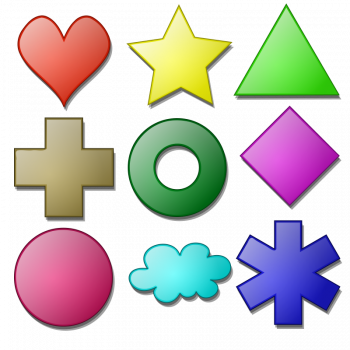
(Image from OpenClipart.)
You’ve got the colours, and now you need formene (the shapes). 🙂
- You can certainly guess what sirkel [SEERkel] means. Another word for the roundest of shapes is runding (”round thing”).
- Strek is a common word for linje [LEENyeh] (line). When you’re drawing shapes, it’s hard to avoid streker. Some of them get together to make a vinkel (angle).
- In the Norwegian flag, two blue bars cross each other and become a … kors (cross).
- A trekant (”three-edge”) is a triangle, and I’m quite sure you know what the following words mean: firkant, femkant, sekskant…
- A firkant where all four sider (sides) are like lange (”equally long”) is a kvadrat [kvahDRAAHT]. The word, however, is much less used in ordinary speech than ”square” in English. 🙂 Most of the times, firkant will do just fine.
- As in English, some shapes are named after things in the ”real world”: stjerne (star), halvmåne [HALLmawneh] (crescent), hjerte [YERteh] (heart).
Turning these nouns into adjectives (”description words”) is easy:
- Sola er rund. (The sun is round.)
- Fjellet er trekantet. (The mountain is triangular.)
- Hytta er firkantet. (The cabin is rectangular/square.)
Please note that these -kantet adjectives get an -e in some settings (when describing plural nouns and attached to definite nouns), just like most Norwegian adjectives. BUT they can also turn into -kantede, which is equally correct. (Yes, I know, poor language learners…) So, you can either say Har du sett det trekantete fjellet? or Har du sett det trekantede fjellet? (Have you seen the triangular mountain?) In real life, most Norwegians would say Har du sett det trekanta fjellet? (And also: Fjellet er trekanta.) To top the confusion, that is ALSO okay to write – even if words with a-endings do look sligthly less formal to many Norwegians.
Finally, we need a mønster (pattern) for our tegning (drawing). 🙂
- Gardinet har prikker. Det er prikket(e). (The curtain has got spots on it. It’s spotted.)
- Genseren har striper. Den er stripet(e). (The sweater has got stripes on it. It’s striped.)
- Skjørtet har blomster. Det er blomstret(e). (The skirt has got flowers on it. It’s flowered.)
- Kilten har ruter. Den er rutet(e). (The kilt has got squares on it. It’s chequered.)





